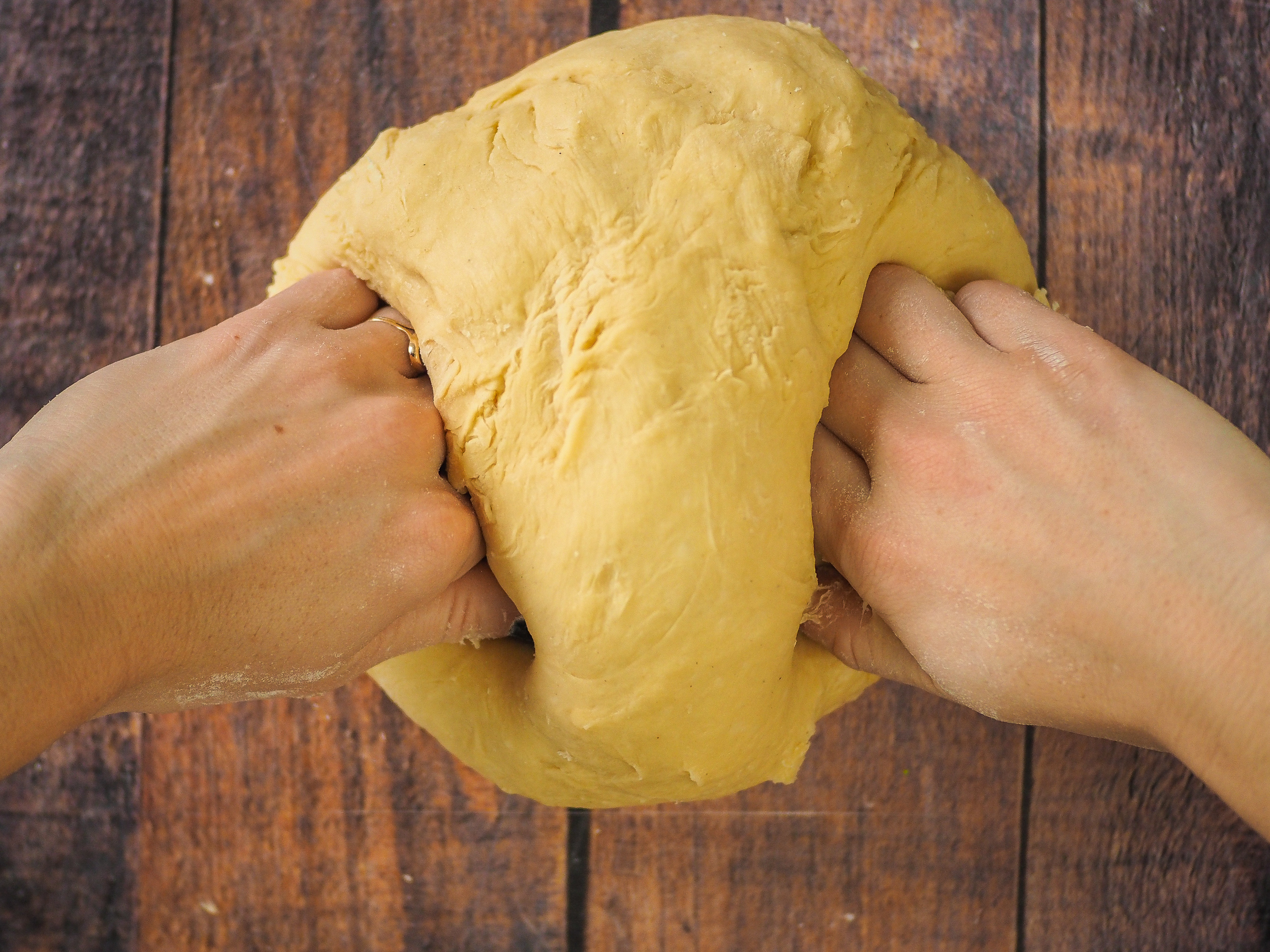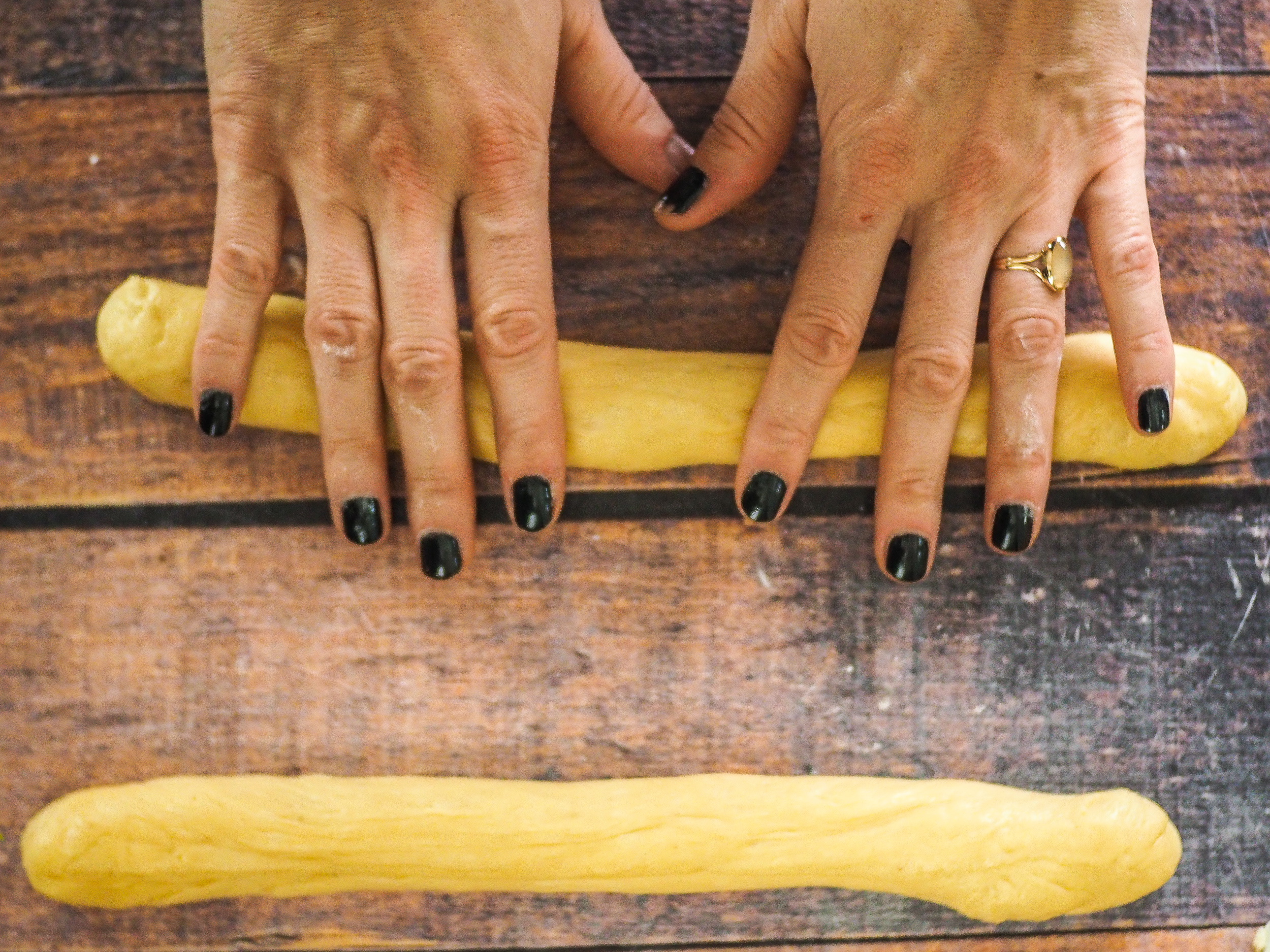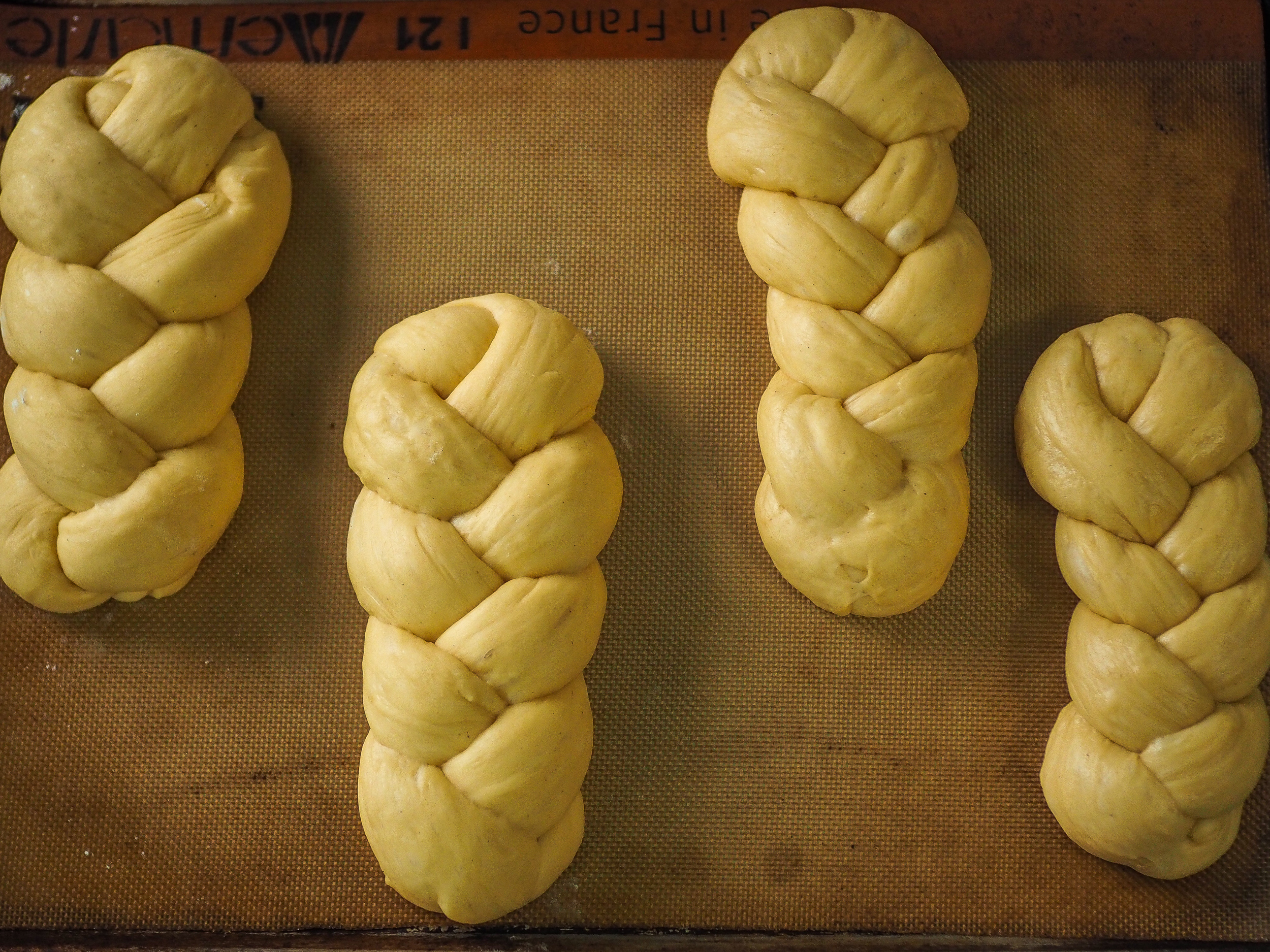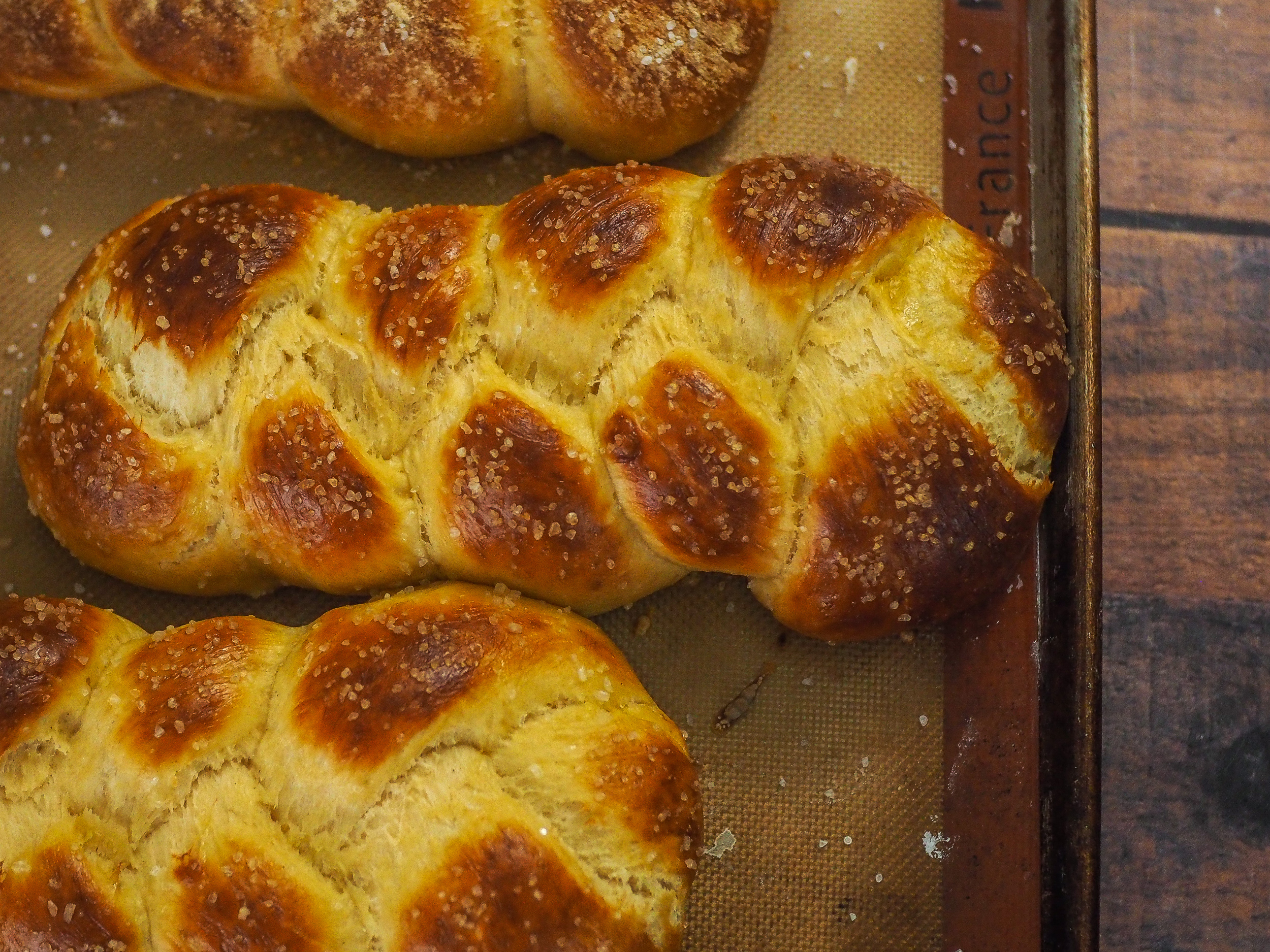Pretzel Challah

The original recipes that this one is cobbled together from all come from the affable millennial Jewish baking queen, Molly Yeh, but for safety reasons I have chosen to rip the steps apart and piece them back together in a way that does not call for the addition of LYE (of all things). Molly’s wayback recipe for pretzel challah is burnished brown in a way that seems unachievable through normal means, which is quite true if you consider having to wear safety goggles and handle chemicals abnormal means of completing a recipe. She seems to have at some point in history realized that no sane person was going to risk the integrity of their eyes and skin just to eat pretzel challah, and subsequent variations on the recipe have adjusted as needed; however, the original is still the only one that guides you through making a full pretzel challah, versus say, pretzel challah hotdog rolls or pretzel challah bagels. Hence the need for the amalgamation of several recipes into a single one for lye-free pretzel challah loaves. In lieu of the lye, this recipe calls for a baking soda bath – a process that can still not be called simple per se, but certainly a more forgivable one than a lye bath would be. You should still wear rubber gloves for handling the baking soda once it has been baked and is “bath-ready” as it can irritate more sensitive skin, especially skin that has been exposed to the treacherous levels of cold that this week has chosen to gift us with.
Pretzel Challah
Cobbled together from a patchwork of Molly Yeh recipes
Makes 4 10-inch loaves
Ingredients:
¼ cup + 2 tsp white sugar, divided
2 tbsp traditional active dry yeast (~3x8-gr packets)
6 cups all-purpose flour, measured correctly + more for dusting
¼ tsp cardamom
2 tsp kosher salt
¼ cup runny honey
2/3 cup canola (or other neutral) oil
5 large eggs, divided
1 cup baking soda (get a brand-new box if your baking soda is old AF)
Rubber gloves, for handling baking soda bath
Coarse salt, for sprinkling
Directions:
Pour 1 cup warm (not hot) water in a small bowl. Add 2 tsp sugar, sprinkle the yeast over top, and swirl the bowl to just combine. Leave to proof for 5-10 minutes. The yeast should bloom and appear frothy or foamy. If this doesn’t happen, you got a bad batch of yeast and need to start again. While the yeast proofs, mix the flour, cardamom, salt, and remaining ¼ cup sugar in a large bowl or stand mixer. Blend the ingredients on low speed (or whisk) until combined. In a medium bowl, whisk together ½ cup warm water, honey, oil, and 4 eggs. When the yeast is proofed, add it to the flour mixture along with the egg mixture. Mix it all together with a large wooden spoon or on medium-low speed (using the paddle attachment) until just combined, ~30 seconds. Switch to the dough hook (if you have one – otherwise keep using the spoon) and keep kneading the dough on low speed, ensuring that all the flour gets incorporated from the sides and bottom of the bowl. When the dough becomes almost too thick to stir, turn it out onto a clean, well-floured work surface and start kneading by hand. Keep kneading the dough, sparingly adding flour as needed to avoid excessive stickiness, until it has become smooth and is no longer sticky, ~7-10 minutes. Set a timer and actually knead for a full 7-10 minutes.
Line a very large baking sheet (or 2 smaller baking sheets) with parchment paper or silicon mat(s) and dust very lightly with flour; set aside. Once kneaded, split the dough into 2 equal pieces. Set each half in a large oiled bowl, cover both bowls with plastic wrap (or a damp towel), and let the dough rise at room temperature until doubled in volume, ~2 - 2 ½ hours. Make sure the spot where your loaves are rising is draft-free and preferably on the slightly warmer side. While the dough is rising, start on the baking soda bath by preheating the oven to 250 degrees F. Spread the baking soda out on a parchment paper-lined baking sheet and, once the oven is ready, bake it for 1 hour. Set the baking soda aside to cool. Turn the oven up to 375 degrees F.
Once the dough is done rising, divide each dough lump in half, giving you 4 dough lumps in total. Divide each lump into 3 even parts and, working 1 “loaf” at a time, roll each piece into a 1-inch thick rope (1 loaf = 3 ropes). Line the ropes up vertically and pinch them together at 1 end. Braid the ropes together and pinch at the other end. Fold the pinched ends under to smooth and round them out. Very carefully transfer the loaf to the prepared baking sheet (spatulas or flippers can be helpful in this task). Repeat the rolling and braiding process with the remaining 3 loaves. Set the baking sheet(s) of challah into the freezer for 20-30 minutes, or refrigerate for 1 hour.
When the challah is nearly done chilling, put the rubber gloves on. Finish making the baking soda bath by very gradually adding the baked baking soda to a casserole dish or large shallow bowl filled with 2 cups warm water. Make sure to pour the baking soda in in a “dusting” kind of way, so that it can dissolve as easily as possible. Use one of your gloved hands to try and dissolve the baking soda in the water as best you can as it gets “dusted” in. It’s hard to get all of it to dissolve, but you can definitely avoid it becoming a task by not just dumping the baking soda all in at once (which will yield a giant baking soda crystal that, while lovely, will not dissolve easily at all). Use the other gloved hand to scrape the baking soda off of the baking sheet. Once the bath is ready (it’s okay if there are still some coarse bits, but try to get most of it dissolved), work 1 at a time to very carefully dip a chilled loaf into the bath, letting each side soak for ~10 seconds. Carefully remove the loaf to a layer of paper towels and blot to dry. Scrape off any bits of baking soda that stuck to the dough and place the loaf back on the baking sheet. Repeat with remaining loaves.
Beat the remaining egg with a splash of water. Brush the loaves with the egg wash and top with coarse salt to your taste (surprise! I drown mine in salt.) Bake for ~15-17 minutes, rotating the pan(s) from front to back halfway through, until the challah is deeply golden brown on top, but NOT burned on the bottom. Transfer to wire racks and let cool to warm. Cut into fat slabs, slather on the butter and languish in the deep deep pleasure that is white bread + butter + copious amounts of salt.





